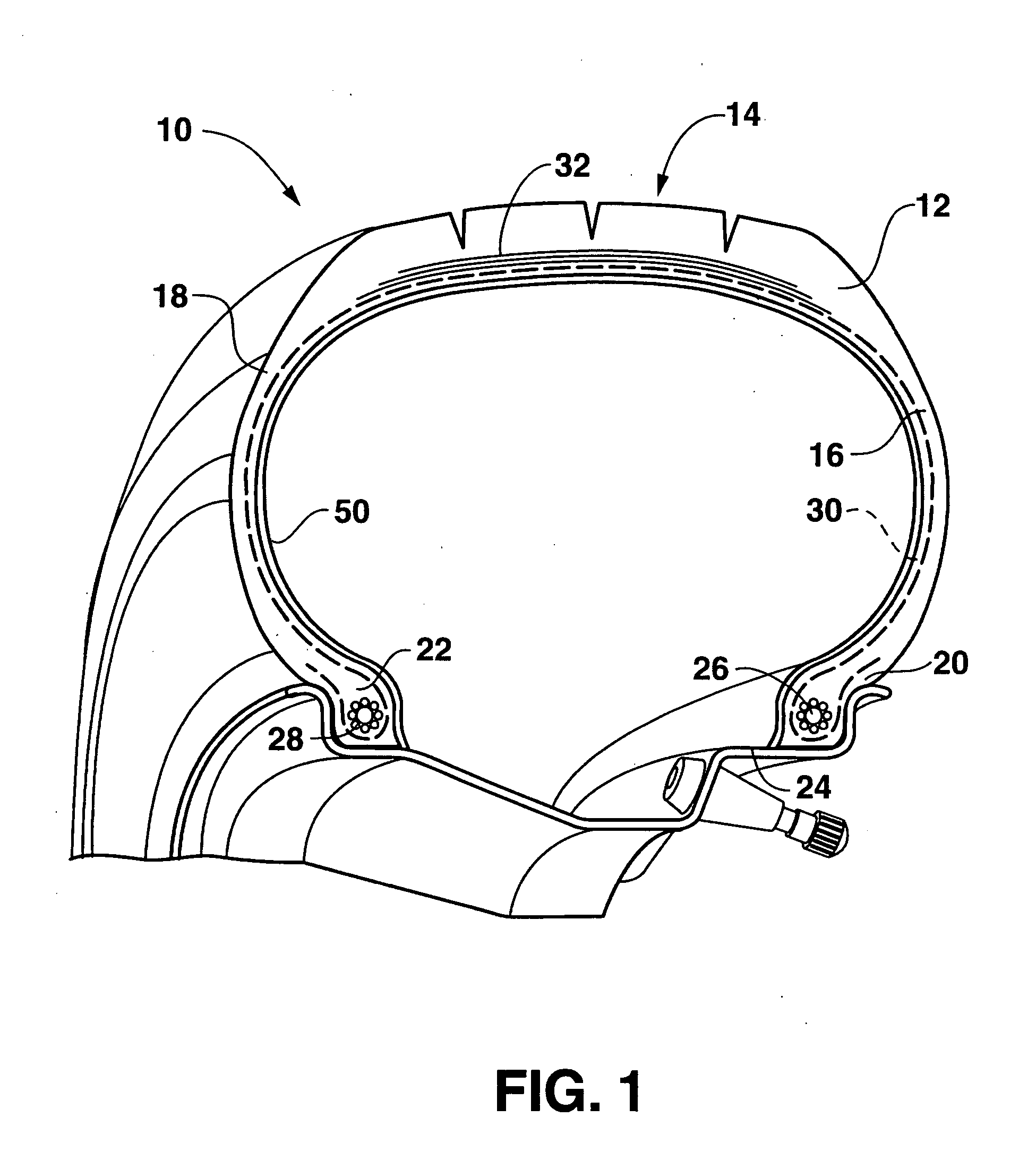Barrier layer for elastomeric articles
a technology of elastomer and barrier layer, which is applied in the field of elastomers, can solve the problems of article performance, article deflate, deleterious effects on the properties of elastomers, etc., and achieve the effect of improving the performance of articles
- Summary
- Abstract
- Description
- Claims
- Application Information
AI Technical Summary
Benefits of technology
Problems solved by technology
Method used
Image
Examples
examples
[0070] The following tests were conducted in order to demonstrate the benefits and advantages of barrier layers made in accordance with the present invention.
[0071] In the examples that follow, the following test methods were used to obtain the data that is presented.
Test Methods
[0072] Mooney Plasticity (ML 1+4): Mooney Plasticity is measured in accordance with ASTM Standard D1646-04. In general, the composition in an uncured state is molded in a cylindrical enclosure and heated to 100° C. After 1 minute of preheating, the rotor turns within the test sample at 2 rpm, and the torque used for maintaining this movement is measured after 4 minutes of rotation. The Mooney Plasticity is expressed in “Mooney units” (MU, with 1 MU =0.83 Newton-meter).
[0073] Modulus @10%: Tensile modulus at 10% elongation (ASTM D412-98a).
[0074] Modulus @100%: Tensile modulus at 100% elongation (ASTM D412-98a).
[0075] Tensile: % elongation at break (ASTM D412-98a).
[0076] Permeability: The oxygen permea...
example 3
[0089] The procedures of Example 1 were again repeated. In this example, however, a styrene butadiene rubber elastomer was used. Two compositions were formulated during this example. One formulation as described below contained terpene resin Sylvares 7215 while a control formulation did not contain the hydrocarbon resin.
(phr)Elastomer (SBR)100Carbon Black (N772)51Curatives3.5Organoclay (Cloisite 6A)5Resin Sylvares 721510
[0090] The compositions were mixed in a 2 liter Banbury mixer. Elastomers were masticated with the organoclay for 1 minute at 40 RPM. The rotor speed was then increased to 60 RPM, and the carbon black, chemicals, and resins were added. The mix was finally dropped out at a maximum temperature of 165° C. A cure package was added on a cool mill. Plaques were cured for mechanical properties testing using optimum cure conditions determined by a MDR rheometer at 150° C.
[0091] Addition of 10 phr of the high Tg resin Sylvares 7125 decreased the viscosity 11.6 MU (16.1%) i...
examples 4-10
[0093] In the following examples, elastomer films were formed containing different plasticizers. In particular, one formulation contained no plasticizer, three formulations contained terpene resins in accordance with the present invention (Examples 4-6), and four formulations contained conventional plasticizers (Examples 7-10). The properties of the resulting films were then compared. The formulations used in these examples are as follows:
(phr)Elastomer (BIMS)100Carbon Black (N772)51Tack Resin2.5Curatives5.7Organoclay (Cloisite 6A)5Plasticizer10
[0094] The formulations were mixed in accordance with the procedure outlined in Example 1. Table 8 details the plasticizing effects of various hydrocarbon based resins in a BIMS formulation in comparison to the properties of formulations not containing a plasticizing resin and formulations containing conventional plasticizers. Examples 4-6 made according to the present invention contained a terpene resin, specifically a polyalphapinene resi...
PUM
| Property | Measurement | Unit |
|---|---|---|
| softening point | aaaaa | aaaaa |
| softening point | aaaaa | aaaaa |
| glass transition temperature | aaaaa | aaaaa |
Abstract
Description
Claims
Application Information
 Login to View More
Login to View More - R&D
- Intellectual Property
- Life Sciences
- Materials
- Tech Scout
- Unparalleled Data Quality
- Higher Quality Content
- 60% Fewer Hallucinations
Browse by: Latest US Patents, China's latest patents, Technical Efficacy Thesaurus, Application Domain, Technology Topic, Popular Technical Reports.
© 2025 PatSnap. All rights reserved.Legal|Privacy policy|Modern Slavery Act Transparency Statement|Sitemap|About US| Contact US: help@patsnap.com

